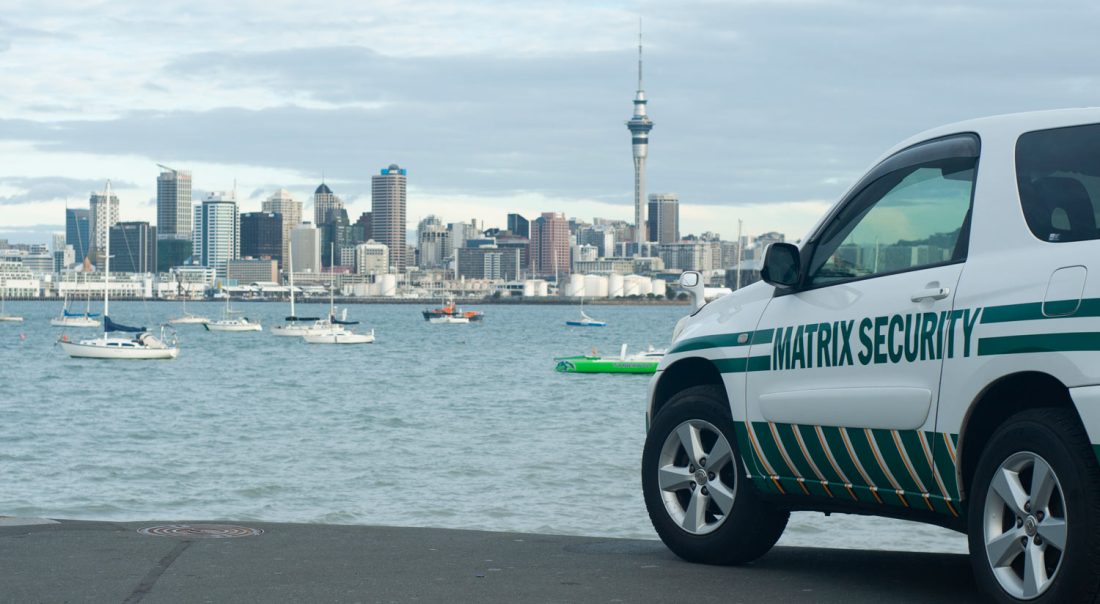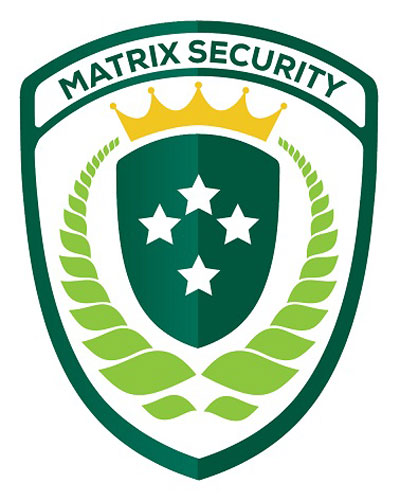The safe keeping of your business premises is a top priority for the RBA
It is important that our members have full confidence in the security of their business in the Rosebank peninsula and we are proud that Rosebank has one of the lowest crime rates of any commercial area in the Auckland region. This was bought about back in 2002 when a group of Rosebank businesspeople met to do something about crime in the area and formed the Rosebank Business Association (RBA). They then contracted a security firm and regular security patrols commenced.
In November 2021 the Rosebank Business Association made the decision to partner with Matrix Security Group to deliver even better security solutions to our members. This opportunity allowed us to focus on our core objective of working with local businesses to implement improvements to create a Safer, Cleaner & Smarter Business community.
Established in 1993, Matrix Security Group Limited have a long legacy as a credible and professional security company to both commercial and residential clients. The Auckland established business is wholly New Zealand owned and operated, with bases in Avondale, Penrose, Takapuna, and East Tamaki.
Their services are fully integrated and specifically tailored for each client. As well as security guards and mobile patrols, they install, monitor and service a range of security alarm systems that work in conjunction with the latest technologies in mobile apps and IP technology.
Matrix Security have become a Platinum Partner of the Rosebank Business Association and continue to participate in the RBA Crime Prevention Action Group.
Physical security for business
Introduction
Physical security describes measures that are designed to protect and safeguard buildings, assets and people from unauthorized individuals, and reduce the threats of theft, burglary, shop-lifting, vandalism, fraud, violence and accidents.
While network and cyber security are also important, preventing physical security breaches is key to ensuring the safety of your data and technology.
Physical security involves the use of multiple layers of interdependent systems that can include:
- locks
- alarms and monitoring
- access control systems
- video surveillance, verification, and monitoring
- security and patrol officers
- protective barriers
- power and fire protection
- environmental
A comprehensive physical security plan must include situational crime prevention strategies. Situational crime prevention is “comprising measures (1) directed at highly specific forms of crime (2) that involve the management, design or manipulation of the immediate environment in as systematic and permanent a way as possible (3) so as to reduce the opportunities for crime and increase the risks as perceived by a wide range of offenders”.
Examples of situation crime prevention include:
- alarm tags on clothing to increase the perceived effort of a crime
- environmental design to improve lighting and visibility to prevent intruders being able to conceal attempts to enter a building
- regular cleaning off graffiti and other malicious damage to reduce the sense of reward the offender may feel and to deter further damage
- video surveillance and improved lighting in carparks to deter vehicle theft and damage.
In addition to the examples above which can be described as outside risks, your plan should mitigate internal risks. Examples of the factors that lead to vulnerability include:
- tailgating (into carpark or following person who has swiped through to gain access to controlled areas)
- disposing of information, data, devices in unsecured areas
- employees forgetting to set alarms or lock doors
- employees sharing access control and IT credentials with others
- employees not knowing escalation processes and protocols in the event of security breaches
- slow responses to security incidents.
Before updating a physical security system, it’s important to understand the different roles technology and barriers play in your strategy. As discussed, the most robust physical security plans take a layered approach.

There are four main components to a physical security plan and your plan should address each of these components, detailing the technology and processes you’ll use to ensure total protection and safety.
1: Prevention – The physical security measures that keep people out or away from the space. Preventative security components can be a physical barrier, such as a bollard or turn style. Security Officers and employee/visitor access protocols assist in providing a visual representation of your commitment to security. Smart locks, access control systems and video surveillance cameras can also act as a deterrent to unauthorized individuals from attempting to access the building.
2: Detection – The components of the solution that help to identify potential intruders or security incident. Sensors, alarms, and automatic notifications are all examples of physical security detection.
3: Interrupt – There are certain security systems that are designed to slow intruders down as they attempt to enter a facility or building. Access control, such as requiring a key card or mobile credential, is one method of delay. Smart physical security strategies have multiple ways to delay intruders, which makes it easier to mitigate a breach before too much damage is caused.
4: Respond – These are the specific actions that need to take place in the event of a security breach. This will range from a security officer response to an alarm activation and the specific instructions for them to follow once onsite, to documenting and training employees and suppliers in the protocols for any security breach.
Assess your risk level
To begin the process of developing a plan, determine the potential risks and weaknesses in your current security.
Download the Matrix Security Physical Security Audit Checklist (DOC).
Although developed for mandatory adoption by Government Departments in mind, the Protective Security Requirements (PSR) have established best practice procedures which can be adopted by any New Zealand business – big or small.
They have developed an indepth self-assessment tool to identify your current capabilities.
The New Zealand Police have also created an online questionnaire to help with providing advice relevant to your situation.

Build a security culture
Every person involved in your business contributes to the effectiveness of your security plan.
No amount of investment in physical security will be productive if you do not have the training, procedures and commitment from your people.
It only takes one person forgetting to set an alarm, being tailgated, leaving a reception area unsecured or not reporting lost keys, to compromise the safety of your business.
Make sure your team understands:
- What the security risks are and the implications of a breach to your business
- Your policies and procedures in the event of a security breach, from bomb threats to broken windows.
- To be diligent and to report security issues and incidents
- Potential consequences for individuals who misuse data and/or insider knowledge to exploit your business
- They are encouraged to report potential risk threats and near misses and will be rewarded for doing so.
Best practice involves providing specific security modules when onboarding new recruits, and ongoing training for all employees.
Engage with your neighbours and join your local business association to develop a community that collaborates to mitigate risk.
Employee Awareness training videos:
Remote Workers
Remote workers need to consider the implications of working in a shared area, being aware of who might be able to see what they are typing, hear what they are saying and having access to reading material. Consider supplying privacy screens and enforcing best practice around securing devices and sensitive information. If the risks associated with business information and equipment entering the public domain is high, consider funding security alarm installation and monitoring, smart locks on home-office doors, patrols and document destruction tools.
COVID-19 Security
All offices have unique design elements, and often cater to different industries and business functions. However, the common denominator is that people won’t come to work if they don’t feel safe. The coronavirus pandemic delivered a host of new types of physical security threats in the workplace. When offices closed down and shifted to a remote workforce, many empty buildings were suddenly left open to attack, with no way to manage who was coming and going. Once buildings reopen with limited occupancy, there are still challenges with enforcing social distancing, keeping sick people at home, and the burden of added facility maintenance.
Building and implementing a COVID-19 physical security control plan may seem daunting, but with the right technology investments now, your building and assets will be better protected well into the future.
Consider the protocols and policies and training to provide to your employees, suppliers, and clients. Will you require security officers or employees to manage site access verifying My Vaccine Pass credentials, ensuring the use of appropriate PPE, ensure they scan into the NZ COVID Tracer, and follow any other policies you have implemented.
Your access control system will ideally have occupancy tracking capabilities to automatically enforce social distancing in the workplace.






